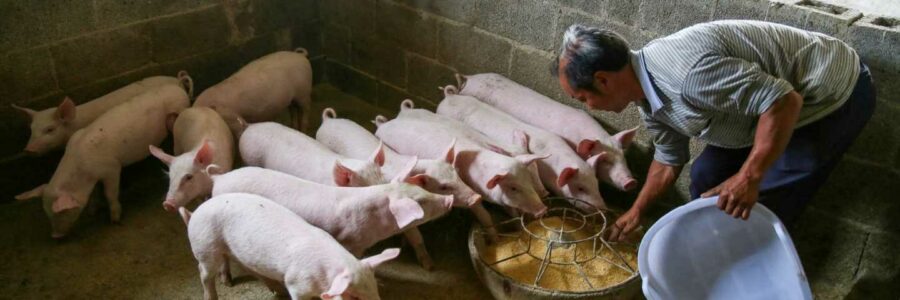
China's hog farmers struggle as pork prices swing and throw off debt-fueled expansion plans
- In less than three years, the gross debt of the top five Chinese pork producers increased by nearly threefold, S&P Global Ratings said in a report Wednesday.
- The outbreak of African swine fever beginning in 2018 decimated herds, and lured many businesses into China's hog industry to take advantage of high prices, government subsidies and easy financing.
- But the rush to expand pork production means the indebted companies now face pork prices that have lost half their value in less than two years.
BEIJING — Massive swings in pork prices in the last two years are roiling China's hog farm industry.
To capitalize on a doubling in prices in 2019, the five largest pork producers sought to expand quickly and increased their gross debt by nearly threefold over 2.5 years, S&P Global Ratings said in a report Wednesday.
But pork prices have tumbled just as quickly as they rose, pressuring the now-indebted producers. The consumer price index released Thursday showed prices for the Chinese meat staple fell 44.9% in August from a year ago.
An outbreak of African swine fever beginning in 2018 swiftly decimated China's hog production by about 40%, according to Flora Chang, associate director at S&P Global Ratings, and an author of the report.
"The high price lured large pork producers to produce more. … They borrowed aggressively to fund expansion," she said, noting that due to the coronavirus pandemic in 2020, financing was easily available.
Entrepreneurs and companies also rushed to take advantage of government subsidies. Zhejiang province promised 1500 yuan or $231 for every breeding sow.
Three years later, that's produced a glut of supply. Pork prices have plunged to around 20 yuan per kilogram ($1.40 per pound), near the same level of early 2019, according to wholesale price data from the agriculture ministry. At their peak in late 2019 and early 2020, pork prices were near 50 yuan per kilogram or higher, the data showed.
Planning challenges
The unprecedented price swings have complicated hog producers' efforts to finance potential growth.
With limited "ability to plan according to price projections," the S&P report noted how companies were suddenly bearing extremely high levels of debt. The analysts said that in the 12 months through June 30, hog producer Wens Foodstuff saw its debt-to-earnings (before interest, taxes, depreciation, and amortization) ratio jump to more than ninefold, up from 1.9 times in 2020.
However, the report noted that Muyuan was less affected by African swine fever and its debt leverage rose only slightly, to 1.3 times from 1, in the 12 months through the end of June.
Government efforts to stabilize prices
Pork is a primary part of Chinese diets and the government has worked to ensure sufficient supply by releasing the meat from national reserves during shortages, and, more recently, encouraging consumption to counter oversupply.
"Recently [pork] prices have fallen very quickly, and [we] hope everyone can take advantage of this opportunity to eat more pork, buy more pork," Ma Youxiang, deputy minister of the Ministry of Agriculture and Rural Affairs, said at a press conference on Sept. 1. That's according to a CNBC translation of the Chinese statement.
The tone was different in 2019, when authorities spoke of encouraging production of not only pork but poultry and beef in order to stabilize prices.
Stock investors also poured in, sending shares of major hog producers like New Hope soaring 174% in 2019. But after additional gains of 16% last year, the stock is down more than 45% for the year so far.
"The drop in pork prices directly affects corporate profits," said Bai Xubo, securities affairs representative at New Hope, noting supply of pork is expected to remain in a surplus, with high levels of imported frozen meat and a backlog at ports while consumer demand remains weak.
That's according to a CNBC translation of a Chinese statement Thursday.
Bai remained confident in the foundation of the company's core business and said the real competitive advantage comes from efforts to improve efficiency. New Hope can also use pork futures and business developments in slaughtering and processing to hedge against price fluctuations.
Read more about China from CNBC Pro
Singapore's top lender picks Chinese stocks for 'bottom fishers'
Morgan Stanley picks out high-conviction China stocks
Mark Mobius: China's regulatory crackdown is creating investment opportunities
It takes about nine to ten months to raise a pig from sow pregnancy to sale, S&P's Chang said.
That's left time for smaller farmers to come into the market when pork prices rise.
In fact, the almost non-existent barrier to entry in the hog industry right now in China has created price volatility of about 10 yuan to 20 yuan every few years as farmers try to ride price changes, Chang said. "Now with [African swine fever] and rising environmental standards, you might see higher barriers to entry."
The analysts expect the market share of the top five producers will likely rise to more than 15%, versus 10.5% in June and compared with 30% for the top five players in the U.S.
Source: Read Full Article